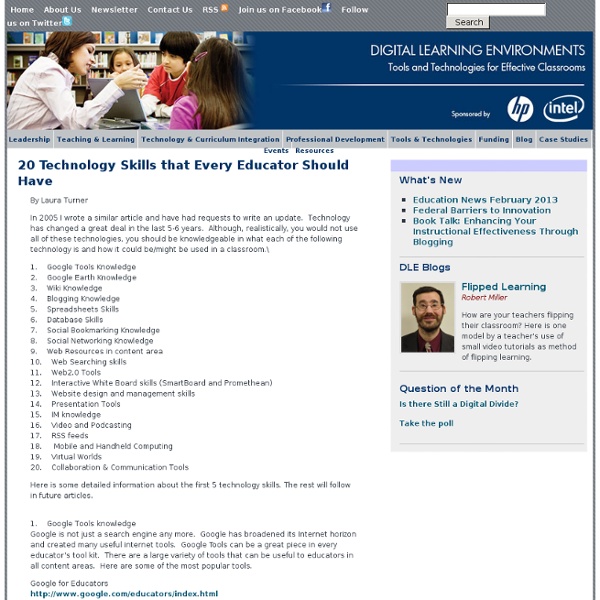Web 2.0 tools in the Classroom - Web 2.0 tools in the Classroom
UPDATE: For the upgraded, interactive version of this course - and to join a community of like-minded educators - go to Teacher-Tech-Training.com. Using technology in the classroom is a great way to encourage creativity in students. Web 2.0 tools, such as , and
A Day in the Life of a Connected Educator – Using social media in 21st century classrooms
One of our main goals at Powerful Learning Practice is to turn educators into 21st Century educators. That is, teach them how to use social media and other powerful Web 2.0 tools to transform their classrooms into learning environments that are ready for today’s iGeneration students. One of the most common questions we get is, “But where do we find the time to use all this new technology?” To answer that question, we developed this infographic – A Day in the Life of a Connected Educator to show that using social media in your classroom and in your life can be integrated, easy, and fun. Scroll down and take a look or click for a larger version. Get connected
- Spread Your Knowledge: 15+ Tools to Bookmark, Aggregate & Curate
0 Comments August 6, 2012 By: Shelly Terrell Aug 5
21st Century Learning is Not A Program
by William Washington, Ed.D. Scholar, Walden University Perhaps the biggest misconception that one can have about 21st century learning is to think of it as a single reform program. 21st century learning is not a singular “thing” that can be plugged into an existing school environment and used as an easy upgrade to improve existing practice. Learning that teaches children how to think is a process with deep philosophical underpinnings and embraces new findings about how people teach, learn, and get motivated. This challenges educational organizations to incorporate new thinking into the ways in which we view the function and purpose of formal education; it implores us to move beyond draconian practices that are rooted in 19th century assumptions about learning.
Webinars – Google Apps for Education
General Learn about all of the features and benefits of Google Apps Education Edition. In this recorded online seminar, you will: Hear why other organizations have made the switch Learn how other organizations are using these services Watch a demo of Google Apps Education Edition Watch Now See a demo of Google Vault.
If you don’t have a PLN, you don’t know what you’re missing!! « NovaNews
Recently I was asked to write an article for an upcoming edition of Connections, a quarterly newsletter produced by the Schools Catalogue Information Service (SCIS), a business unit of Education Services Australia. Aiming to provide informative and useful material relevant to school libraries which helps keep library professionals up to date, Connections is distributed to all schools in Australia in both hard copy and digital formats. I was asked to write specifically about Personal Learning Networks (PLNs) both from a general and personal perspective. I found the process of putting my thoughts together both challenging and inspiring. Not all that long ago, I had never heard of PLNs. Today, I feel part of an amazing community and am unable to comprehend how I could be where I am today without the support and guidance of those in my PLN.
Top Web Tools for Enhancing Collaboration
11/1/2010 By: By Özge Karaoglu It’s not news that collaboration is a proven method for effective teaching, and Web 2.0 has enlarged the possibility of peer collaboration to a global scale.
8 Things to Look For in Today’s Classroom
As I think that leaders should be able to describe what they are looking for in schools I have thought of eight things that I really want to see in today’s classroom. I really believe that classrooms need to be learner focused. This is not simply that students are creating but that they are also having opportunities to follow their interests and explore passions.1 The teacher should embody learning as well. Will Richardson recently wrote this in a comment on one of my recent posts on what teachers need to be like in our current day and the focus that needs to be on learning: …we need teachers who are masters at developing kids as learners who are adept at sense making around their own goals. Teachers who are focused on helping students develop the dispositions and literacies required to succeed regardless of subject or content or curriculumThis moment is all about learners having an amazing new freedom to learn, not teachers having an amazing new freedom to teach.
digitalstorytales
Creating Digital Tales in the Classroom - a learning module for teaching professionals. This learning module begins May 1st and ends May 31, 2011. 30 points/30 prof development hours. Module Overview:
Five Tips for New Teachers to Become Connected Educators
Editor's Note: Connected Educator Month (CEM) was launched by the Department of Education in August 2012, and this year, it's being held in October. This post from Lisa Dabbs is a great primer for becoming a connected educator, and it's a must-read for CEM. (Updated 10/2013)



